
Robertson Tunnel
Encyclopedia
The Robertson Tunnel is a tunnel
through the west hills
of Portland, Oregon
, U.S. for the TriMet
public transit MAX Light Rail system. The tunnel is 3.1 miles (5.0 km) long and consists of twin 21 foot (6.4 m) diameter tunnels. There is one station within the tunnel at Washington Park
, the third deepest such station in the world. The tunnel has won several worldwide engineering and environmental awards. It was placed into service September 12, 1998.
The tunnels pass through basalt
up to 16 million years old. Due to variations in the rock composition, the tunnel curves mildly side to side and up and down to follow the best rock construction conditions. The tunnels vary from 80 to 300 feet (24–91 m) below the surface. A core sample taken during construction is on display with a timeline of local geologic history.
The east tunnel entrance is near Vista Bridge
at the edge of the Goose Hollow
neighborhood at the foot of Washington Park. The west entrance is along U.S. Route 26 just west of the Finley-Sunset Hills cemetery, about a mile east of the junction with Oregon Route 217.
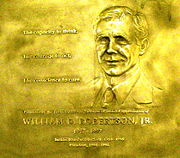
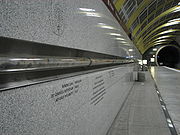 The tunnel is named for William D. Robertson who served on the TriMet board of directors and was its president at the time of his death.
The tunnel is named for William D. Robertson who served on the TriMet board of directors and was its president at the time of his death.
, despite the six percent average grade. Reliability, weather conditions, public opinion, and environmental concerns led to choosing to tunnel through the Tualatin Mountains
instead.
Construction began in the summer of 1993 at the west end employing the conventional mining technique of drilling and blasting
due to the loose mixture of materials. More than 75 tons of explosives were used and mining progressed about a mile into the hill. East end construction began in August 1994 with a customized tunnel boring machine
. About a thousand workers from 230 construction firms were involved in the 18 mile westside MAX line, including those who built the tunnel and installed the reinforced concrete liner, tracks and wiring. One worker was killed while operating equipment.
Tunnel construction continued 24 hours a day, six days per week. The north tunnelers met after 16 months on December 29, 1995, and the boring machine began the south tunnel in April 1996. The south tunnel took only four months before the tunneling teams met on August 15, 1996.
To complete the west end at the cemetery, 14 bodies were relocated.
The original estimate for the tunnel was $103.7 million, but the final price tag came to $184 million, largely due to challenges posed by unexpected loose layers of silt and gravel, and crumbling basalt which prevented the boring machine from working effectively.
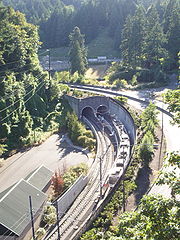
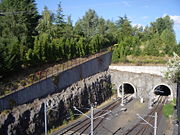
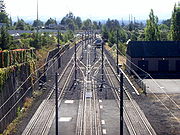 The tunnel generally follows – but remains north of – U.S. Route 26, diverging the most (1/3 mi, 500 m) in the Oregon Zoo
The tunnel generally follows – but remains north of – U.S. Route 26, diverging the most (1/3 mi, 500 m) in the Oregon Zoo
area.
The elevation at the west end is higher than the east but there is very little perceptible slope except for several gentle, short grades which exist presumably to follow the easiest-to-bore rock stratum.
During construction, the east portal was west of Canyon Road
, below City of Portland Reservoir 4. After completion, the road was raised and an overpass placed over the track. This effectively extends the tunnel about 430 ft (130 m) so it emerges on the east side of Canyon Road.
Beginning at the east end (traveling westward), under Canyon Road the tunnel turns SSW (202°
)
for about 300 m (1000 ft) where it turns WSW (236°) under the large field east of the Elephant House. 1200 m (4000 ft) later it is directly under and follows SW Kingston Road at a point 250 m (800 ft) north of the zoo's elephant exhibit. For the next 250 m, it arcs until almost directly westward (263°) and straightens for 300 m (1000 ft) to arrive at the Washington Park station
.
After the station, it passes under the south side of the World Forestry Center
's main building and turns 4° northward (267°) and continues for its longest straight stretch of 900 m (3000 ft). At the point it passes under SW Skyline Road 150 m (500 ft) north of the Sylvan Bridge, it turns slightly southward (253°) and—300 m (1000 ft) later—goes under the Finley-Sunset Hills building and water feature. For the remaining 500 m (1700 ft), it turns right in a long gradual arc exactly paralleling Sunset Hwy. The arc continues at the same rate after the west portals, and is due west (270°) about 500 m (1700 ft) past the portals.
Tunnel
A tunnel is an underground passageway, completely enclosed except for openings for egress, commonly at each end.A tunnel may be for foot or vehicular road traffic, for rail traffic, or for a canal. Some tunnels are aqueducts to supply water for consumption or for hydroelectric stations or are sewers...
through the west hills
Tualatin Mountains
The Tualatin Mountains are a range of hills on the western border of Multnomah County, Oregon, United States...
of Portland, Oregon
Portland, Oregon
Portland is a city located in the Pacific Northwest, near the confluence of the Willamette and Columbia rivers in the U.S. state of Oregon. As of the 2010 Census, it had a population of 583,776, making it the 29th most populous city in the United States...
, U.S. for the TriMet
TriMet
TriMet, more formally known as the Tri-County Metropolitan Transportation District of Oregon, is a public agency that operates mass transit in a region that spans most of the Portland metropolitan area in the U.S. state of Oregon...
public transit MAX Light Rail system. The tunnel is 3.1 miles (5.0 km) long and consists of twin 21 foot (6.4 m) diameter tunnels. There is one station within the tunnel at Washington Park
Washington Park (MAX station)
Washington Park is a station in the MAX Light Rail system of TriMet, served by the Blue and Red lines. It is located in Portland, Oregon and is a part of the Robertson Tunnel under Portland's West Hills. It is the fourth station westbound on the Westside MAX alignment...
, the third deepest such station in the world. The tunnel has won several worldwide engineering and environmental awards. It was placed into service September 12, 1998.
The tunnels pass through basalt
Basalt
Basalt is a common extrusive volcanic rock. It is usually grey to black and fine-grained due to rapid cooling of lava at the surface of a planet. It may be porphyritic containing larger crystals in a fine matrix, or vesicular, or frothy scoria. Unweathered basalt is black or grey...
up to 16 million years old. Due to variations in the rock composition, the tunnel curves mildly side to side and up and down to follow the best rock construction conditions. The tunnels vary from 80 to 300 feet (24–91 m) below the surface. A core sample taken during construction is on display with a timeline of local geologic history.
The east tunnel entrance is near Vista Bridge
Vista Bridge
The Vista Bridge is an arch bridge for vehicles and pedestrians located in Portland, Oregon, United States. It connects the areas of King's Hill and Vista Ridge which are both in the Goose Hollow neighborhood...
at the edge of the Goose Hollow
Goose Hollow, Portland, Oregon
Goose Hollow is a neighborhood in southwest Portland, Oregon. It acquired its distinctive name through early residents’ practice of letting their geese run free near the wooded ravine in the Tualatin Mountains now known as the Tanner Creek Canyon and in the now infilled Tanner Creek Gulch...
neighborhood at the foot of Washington Park. The west entrance is along U.S. Route 26 just west of the Finley-Sunset Hills cemetery, about a mile east of the junction with Oregon Route 217.
Name


History
Originally, it was expected that the westside MAX line would be adjacent to the Sunset HighwaySunset Highway (Oregon)
The Sunset Highway No. 47 , in the state of Oregon, is an official designation for the portion of U.S. Route 26 between its western terminus, south of Seaside, and the interchange with Interstate 405 in downtown Portland...
, despite the six percent average grade. Reliability, weather conditions, public opinion, and environmental concerns led to choosing to tunnel through the Tualatin Mountains
Tualatin Mountains
The Tualatin Mountains are a range of hills on the western border of Multnomah County, Oregon, United States...
instead.
Construction began in the summer of 1993 at the west end employing the conventional mining technique of drilling and blasting
Drilling and blasting
Before the advent of tunnel boring machines, drilling and blasting was the only economical way of excavating long tunnels through hard rock, where digging is not possible. Even today, the method is still used in the construction of tunnels, such as in the construction of the Lötschberg Base Tunnel...
due to the loose mixture of materials. More than 75 tons of explosives were used and mining progressed about a mile into the hill. East end construction began in August 1994 with a customized tunnel boring machine
Tunnel boring machine
A tunnel boring machine also known as a "mole", is a machine used to excavate tunnels with a circular cross section through a variety of soil and rock strata. They can bore through anything from hard rock to sand. Tunnel diameters can range from a metre to almost 16 metres to date...
. About a thousand workers from 230 construction firms were involved in the 18 mile westside MAX line, including those who built the tunnel and installed the reinforced concrete liner, tracks and wiring. One worker was killed while operating equipment.
Tunnel construction continued 24 hours a day, six days per week. The north tunnelers met after 16 months on December 29, 1995, and the boring machine began the south tunnel in April 1996. The south tunnel took only four months before the tunneling teams met on August 15, 1996.
To complete the west end at the cemetery, 14 bodies were relocated.
The original estimate for the tunnel was $103.7 million, but the final price tag came to $184 million, largely due to challenges posed by unexpected loose layers of silt and gravel, and crumbling basalt which prevented the boring machine from working effectively.
Route



Oregon Zoo
The Oregon Zoo, formerly the Washington Park Zoo, is a zoo in Portland, the largest city in the U.S. state of Oregon. Located southwest of Downtown Portland, the zoo is inside Portland's Washington Park, and includes a narrow-gauge railway that connects to the International Rose Test Garden inside...
area.
The elevation at the west end is higher than the east but there is very little perceptible slope except for several gentle, short grades which exist presumably to follow the easiest-to-bore rock stratum.
During construction, the east portal was west of Canyon Road
Canyon Road
Canyon Road is a road connecting Beaverton and Portland, Oregon, United States. It was the first road between the Tualatin Valley and Portland and contributed significantly to Portland becoming the area's major deep water port, and subsequent early growth of the city.The total modern length is...
, below City of Portland Reservoir 4. After completion, the road was raised and an overpass placed over the track. This effectively extends the tunnel about 430 ft (130 m) so it emerges on the east side of Canyon Road.
Beginning at the east end (traveling westward), under Canyon Road the tunnel turns SSW (202°
Degree (angle)
A degree , usually denoted by ° , is a measurement of plane angle, representing 1⁄360 of a full rotation; one degree is equivalent to π/180 radians...
)
for about 300 m (1000 ft) where it turns WSW (236°) under the large field east of the Elephant House. 1200 m (4000 ft) later it is directly under and follows SW Kingston Road at a point 250 m (800 ft) north of the zoo's elephant exhibit. For the next 250 m, it arcs until almost directly westward (263°) and straightens for 300 m (1000 ft) to arrive at the Washington Park station
Washington Park (MAX station)
Washington Park is a station in the MAX Light Rail system of TriMet, served by the Blue and Red lines. It is located in Portland, Oregon and is a part of the Robertson Tunnel under Portland's West Hills. It is the fourth station westbound on the Westside MAX alignment...
.
After the station, it passes under the south side of the World Forestry Center
World Forestry Center
The World Forestry Center is an American nonprofit educational institution in Portland in the U.S. state of Oregon. Located near the Oregon Zoo in Washington Park, the center was established in 1964 as the Western Forestry Center.-History:...
's main building and turns 4° northward (267°) and continues for its longest straight stretch of 900 m (3000 ft). At the point it passes under SW Skyline Road 150 m (500 ft) north of the Sylvan Bridge, it turns slightly southward (253°) and—300 m (1000 ft) later—goes under the Finley-Sunset Hills building and water feature. For the remaining 500 m (1700 ft), it turns right in a long gradual arc exactly paralleling Sunset Hwy. The arc continues at the same rate after the west portals, and is due west (270°) about 500 m (1700 ft) past the portals.

